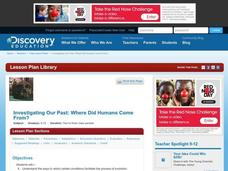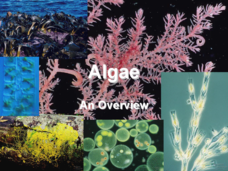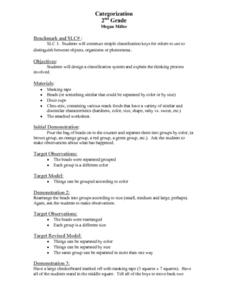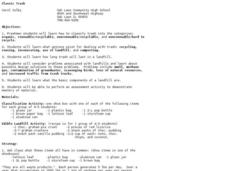Biology Junction
Mollusks
Mollusks created every shell on Earth. Young scientists learn more about the phyllum mollusca in an informative presentation. It covers their characteristics, body plans, and relationships in the ecosystem. Then, it details each class of...
Curated OER
Investigating Our Past: Where Did Humans Come From?
Investigate the theories of human evolution. In this research based lesson, learners research and discuss how geographic isolation, interbreeding, generalization, and specialization are factors in the history of humans. Groups work...
Curated OER
Algae: An Overview
The main characteristics and definitive features of red, green, brown, and 4 other algea are listed along with great photos and examples. The details involved with reproduction styles, and information about traits of each Phyla are...
DePaul University
The Working Tools of Insects
The animal kingdom is full of interesting organisms that have unique ways of surviving. Children read about different insects that have special tools for building homes and protecting themselves. When finished, learners identify the main...
Curated OER
Categorization
Second graders participate in a teacher led bead sorting activity in which they describe different ways the beads can be grouped. Next, they participate in activities in which they sort and resort themselves into groups according to...
Curated OER
How Are Animals Classified?
In this animal classification worksheet, students describe the animal kingdom including invertebrates, vertebrates, birds, and mammals. This worksheet is a graphic organizer.
Curated OER
Reptiles and Birds
In this classification worksheet, students review 5 vocabulary terms that describe reptiles or birds. These 5 terms are placed into a crossword puzzle.
Curated OER
What's in a Name?
Students study the binomial system of naming organisms. They are given a name of an organism and they must draw a picture of what they think the organism looks like. Then they research the organism, find what it really looks like, and...
Curated OER
What's In A Name?
Students explore the concept of the binomial system of nomenclature for classifying organisms. Students travel on a field trip to observe organisms displayed and their common names. Students complete several classroom activities and...
Curated OER
Let Me Tell You About My Favorite Animal
Students create books about their favorite animals using graphic organizers.
Curated OER
Discovering Dichotomous Keys
High schoolers become familiar with the structure and use of dichotomus keys. They demonstrate a comprehension of the fundamental principles of taxonomy by classifying organisms from a local ecosystem. Students are introduced to the...
Curated OER
Keying Rocks
Fifth graders observe several examples of types of rock and write about their similarities and differences in their science journals. They discuss their observations and discover that rocks are grouped according to the scientific...
Curated OER
Specialty Crop Production/Orchids
Twelfth graders explore the fascinating world of orchid production including propagation, care, culture, and finishing. They complete market research and design a production schedule for an orchid crop of their choice. They write a short...
Curated OER
Classifying Objects
Fourth graders classify living things according to similarities and differences through guided and independent activities. They place objects into groups according to their characteristics and then make a collage of living things...
Curated OER
Studying Fossils
Students compare and contrast key skeletal differences between chimpanzees and humans: brain size, teeth, hand and thumb, trunk, pelvis, lower limb, foot and big toe. They then sort and group a set of mixed "fossil bones" of chimpanzee...
Curated OER
Comparing Fossils
Students explore early hominid evolution as they analyze bones that share characteristics of both apes and humans. Students compare and contrast key skeletal differences between chimpanzees and humans. In groups, they sort and group a...
Curated OER
So You Think You're Tough
Fourth graders learn how to classify animals. In this invertebrates lesson, 4th graders discuss how we classify thinks into groups and move into a discussion about classifying animals. Students learn about the differences between...
Curated OER
A Wild Family Album!
Young scholars create a scrapbook style family album for a selected animal. They complete an interactive Internet activity on research reports, fill out a graphic organizer, diagram a food web, and complete their scrapbook that includes...
Curated OER
Edible Algae
Students acquire an awareness and appreciation for the value of the organisms in the Protist Kingdom. They identify common Protists, name them and list some common products that contain marine algae.
Curated OER
2004 Asian Earthquake and Tsunami Disaster Project
Students are employees of a unit of the United Nations, they are responsible for coordinating disaster relief after a major disaster (the 2004 Asian Earthquake and Tsunami) occurs. The agency needs to understand the situation in each...
Curated OER
Are Viruses Alive: Sample Socratic Questions
Students comprehend the definition and uniqueness of life and its complexities. They examine what characteristics constitute a living organism. Students recognize the extent of the role viruses play in the movement and molding of life as...
Curated OER
Bird Beaks
Students discover the beaks of birds. In this biology lesson plan, students explore how many different birds can live in the same geographical area because they are adapted to eat different organisms.
Curated OER
Classic Trash
Students investigate how trash is classified and the options to deal with it. In this trash and recycling instructional activity, students perform an activity to classify trash into organic, renewable/ recyclable, now...
Curated OER
Chicago: The City in Art, 1995-2000
Students examine a mural of animals and talk about animal classification. They act as scientists and keep a record, called a Jungle Journal, of plants and animals they observe while studying the rainforest.

























